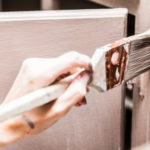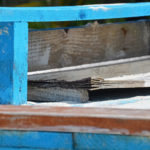How often do you clean your paint brushes? It’s important to keep them clean so they don’t get clogged up with dried paint. The more time it takes for the brush to put down paint, the less effective it is at getting work done.
Here are 13 ways to make sure your brushes stay in top condition.
Method 1: Clean with Soap and Water
Pour some liquid dish soap onto your paintbrush.
Work it into the bristles until they are clean. Use warm water to rinse out all of the suds, then blot them dry on a rag or roll up paper towels at the base of each bristle so that excess water doesn’t seep into the ferrule.
Method 2: Mix Olive Oil and Dish Soap
Mix olive oil with dish soap to make a paste, then rub this onto your paintbrush (just like you would toothpaste on a toothbrush). Work it in using circular motions until the brush is clean. Rinse everything out and let your bristles dry naturally – don’t dry them with a towel otherwise you’ll ruin their shape.
Method 3: Wash with White Vinegar and Water
Pour white vinegar onto your paintbrush.
Work it into the bristles until they are clean. Use warm water to rinse out all of the suds, then blot them dry on a rag or roll up paper towels at the base of each bristle so that excess water doesn’t seep into the ferrule.
Method 4: Spray WD-40
Spray WD-40 onto the bristles of your paintbrush, then work it into this area using circular motions until all of the dried paint is removed and your brush looks new again. Once you’re done cleaning, rinse out the bristles with warm water and let them dry naturally.
Method 5: Mix Vinegar, Dish Soap, and Water
Mix together equal parts white vinegar, dish soap, and water in a spray bottle to make your own paintbrush cleaning solution. Spray the bristles of the brush until they’re soaking wet – this will help loosen up any dried paint so that it can be rinsed out.
Once done, rinse the bristles with warm water and blot them dry using a rag or paper towels at their base so that excess moisture doesn’t seep into the ferrule.
Method 6: Lighter Fluid Method
Pour some lighter fluid onto your paintbrush – just enough to cover its bristles. Let it soak in for a few seconds, then use long, gentle strokes to pull the paint off your brush and down into the lighter fluid.
Continue doing this until all of the dried-on paint has been wiped away – you might need to add lighter fluid if needed (but don’t get too carried away).
Once done, take your paintbrush outside and use long, even strokes to wipe off the lighter fluid (you might need to do this a few times). Finally, rinse your paintbrush with warm water until all the suds are gone.
Blot them dry using paper towels or rags at their base so that excess moisture doesn’t seep into the ferrule.
Method 7: Denatured Alcohol
Mix together equal parts denatured alcohol and dish soap to make a paste, then rub this into your paintbrush (just like you would toothpaste on a toothbrush). Work it in using circular motions until the brush is clean.
Rinse everything out with warm water and blot them dry using paper towels or rags at their base so that excess moisture doesn’t seep into the ferrule.
Method 8: Cleaning Fluid
Mix dish soap and water in a spray bottle, then spritz this onto your paintbrush (just enough to dampen it) – you don’t need too much liquid because cleaning fluid is incredibly potent.
Let it sit for about 30 seconds, then use long, gentle strokes to wipe off the paint. Continue doing this until all of the dried-on paint has been wiped away – you might need to spritz your brush with more cleaning fluid if needed (but don’t get too carried away).
Once done, take your paintbrush outside and use long, even strokes to wipe off the cleaning fluid (you might need to do this a few times). Finally, rinse everything out with warm water until all of the suds are gone. Blot them dry using paper towels or rags at their base so that excess moisture doesn’t seep into the ferrule.
Method 9: Clean with Brush Cleaner
Brush cleaner is a solvent designed to break down and remove many mediums from paintbrushes. It doesn’t evaporate like water, so it also helps prevent rusting in the ferrule (the metal part that holds the bristles together) and removes dried-on paint particles.
Pour some brush cleaner into a cup, then submerge the bristles until they are saturated. Work it in with your fingers or swish it around gently inside the cup before rinsing it with warm water.
Blot dry on another rag or paper towel, careful not to let excess liquid seep into the ferrule.
Method 10: Clean with Nail Polish Remover
This method requires a bit of extra caution, as it involves working with highly flammable and potentially toxic chemicals inside your home.
The upside is that this material will effectively dissolve any mediums stuck in the bristles while also drying quickly to prevent rusting or mold.
Pour some clear nail polish remover into a cup, then submerge the bristles until they are saturated and work it in with your fingers or swish it around gently inside of the cup before rinsing with warm water. Blot dry on another rag or paper towel, being careful not to let any excess liquid seep into the ferrule.
Method 11: Use Paint Thinner
Pour some paint thinner onto your brush.
Work it into the bristles until they are clean, then rinse them with water and blot them dry as before.
If you have used oil-based paints or stains on your brushes, use mineral spirits instead of paint thinner so that you don’t accidentally remove any of the finish from the wood along with the dried paint.
Method 12: Clean with Bleach and Water
When mixed, bleach is a highly effective cleaner that can remove dried paint from bristles while helping prevent rusting in the ferrule.
Mix ¼ cup distilled white vinegar with ½ teaspoon laundry detergent and add this solution to one cup of boiling water.
Method 13: Clean with Mineral Spirits
Pour a small amount of mineral spirits into your paint tray.
Place the brush bristles down into it, then use gentle strokes to work up and down the length of each bristle until they are clean. Make sure not to submerge any part of the metal ferrule in water or solvent, as this can loosen the glue in place.




